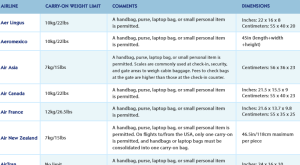I’ve seen two recent stories about things falling out of the overhead bin and injuring people. In the first instance an older lady was knocked  unconscious by a shoe falling out of a bin during a flight. In the second story a man says he suffered a compressed disc when luggage fell on him from the overhead bin during the boarding process. What may be surprising to you is in both of these stories the victims are blaming the airlines. The elderly woman said the incident with the shoe happened because airlines are charging fees for checking bags, which encourages people to overpack their carryon. The man that had the carryon luggage fall on him is blaming the airlines (and suing for $49,000) for letting the passenger bring luggage on board that’s too big for the overhead bin, and for not training the flight attendants to properly deal with luggage in packed overhead bins.
unconscious by a shoe falling out of a bin during a flight. In the second story a man says he suffered a compressed disc when luggage fell on him from the overhead bin during the boarding process. What may be surprising to you is in both of these stories the victims are blaming the airlines. The elderly woman said the incident with the shoe happened because airlines are charging fees for checking bags, which encourages people to overpack their carryon. The man that had the carryon luggage fall on him is blaming the airlines (and suing for $49,000) for letting the passenger bring luggage on board that’s too big for the overhead bin, and for not training the flight attendants to properly deal with luggage in packed overhead bins.
While I do agree that airlines bear some of the burden for incidents such as these, I also believe passengers have a responsibility to consider the safety of others using the overhead bins. Here are some things to remember when using the overhead bins.
Listen to the flight attendants. As you board, the flight attendants will be making a variety of announcements, including any special instructions on getting your suitcase to fit in the overhead bin. Some aircraft the suitcase has to go in wheels first, on some they have to be handle first, and on a few planes full size rollaboards can only fit sideways. On some of the bigger American airplanes the direction doesn’t matter. If the flight attendant doesn’t advise you ask them for clarification because more suitcases fit when people put them in correctly.
Don’t overpack your bag. When you overstuff your bag you end up having to force it into the overhead bin. When you force a bag in you’ll have to force it out as well. I’ve seen a scary moments from people essentially ripping their suitcase out of the overhead bin. There have been some really close calls where people are dodging to not get smacked by flying luggage. If you are packing your carryon so full that you have to force it into the overhead bin you should either be checking your bag or have overflow in your personal item under the seat in front of you. Make sure you can lift your suitcase as well. Flight attendants can’t help you lift your suitcase, and if it’s so heavy that you strain to lift it you’ll have an even harder time controlling it when removing from the overhead bin.
Share the space. Overhead bins are shared space. All too often I see people putting bags in the overhead sideways when it could easily go long ways, or putting a second bag in the overhead that should go under the seat in front of them. These actions affect everyone on the plane. Not only could it cause other passengers to unnecessarily gate check, it delays the boarding process which could cause a late departure. Respect the space.
Don’t bring bags that won’t zip. If you are bringing a carryon that’s not a suitcase but too big to fit under the seat in front of you make sure that the bag at least can zip up. A shoe (or any other items) should not be falling out of the overhead bin!
For a list of airline carryon polices see airfarewatchdog’s post.
Readers, what tips do you have for passengers using the overhead bins? Have you seen anyone injured by carryons from the overhead bin?
Be sure to check out my page with the best carry-on luggage according to readers.
****************************************************************************
Have a travel question or suggestion? Send it to RW @RoadWarriorette.com.
Follow Road Warriorette on Twitter, Facebook, and Pinterest!
This post may include affiliate links. Thanks for your support!




Please allow me to add my two cents.
1, In the case of the man with the alleged back injury, I believe a cabin crew member was assisting with the bag when it fell. This is related to why he is suing the airline, I assume.
2, Properly sized roll on bags usually fit in the overhead bin with wheels in, handle out. They might even fit with wheels in, side down to use very little space. The key is properly sized after measuring height from floor to top. Certain aircraft have hopeless bin measurements, usually on top of an economy two seat section.
The easiest solution is to go with a smaller bag! If you can’t do that then perhaps go with a bag without wheels. Another solution is to go with a European sized carry on (20″ height, 7″ thickness). I’ve never had problems on the plane with Euro bags.
The biggest thing to remind people? If the expansion zipper is unzipped it is no longer carry on sized and MUST be checked.
I agree that the airlines are the crux of the problem. They aren’t measuring the bags and are allowing overweight overstuffed luggage on board. I see it all.the.time.
What airlines need to do is make it mandatory for all customers to test their luggage in one of those little sizing frames they have in the airports — and which I’ve never, ever seen used. In addition, those frames need to be situated horizontally about six feet off the ground. If the passenger can’t lift the bag and get it into the frame, the bag is checked. Problem solved.
Agree airlines are to blame for this fiasco. Charging for checked luggage and also crappy luggage handling encourage people to carry too much on board. They should enforce the volume restrictions, even if weight does not concern them, volume should.
What amazes me is that people with bags that they can’t lift expect flight attendants to help them! If FAs assisted every fool who can’t pack, they’d all have back injuries by the end of day one!
Unfortunately here on your blog you are preaching to the choir as the problem is not frequent flyers but recreational flyers and families who seem to need three thousand bags for children with tiny clothes!